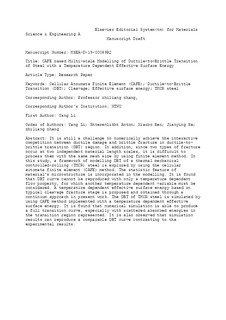| dc.contributor.author | Li, Yang | |
| dc.contributor.author | Shterenlikht, Anton | |
| dc.contributor.author | Ren, Xiaobo | |
| dc.contributor.author | He, Jianying | |
| dc.contributor.author | Zhang, Zhiliang | |
| dc.date.accessioned | 2019-09-18T07:47:02Z | |
| dc.date.available | 2019-09-18T07:47:02Z | |
| dc.date.created | 2019-04-05T10:12:01Z | |
| dc.date.issued | 2019 | |
| dc.identifier.issn | 0921-5093 | |
| dc.identifier.uri | http://hdl.handle.net/11250/2617357 | |
| dc.description.abstract | It is still a challenge to numerically achieve the interactive competition between ductile damage and brittle fracture in ductile-to-brittle transition (DBT) region. In addition, since two types of fracture occur at two independent material length scales, it is difficult to process them with the same mesh size by using finite element method. In this study, a framework of modelling DBT of a thermal mechanical controlled-rolling (TMCR) steel is explored by using the cellular automata finite element (CAFE) method. The statistical feature of material’s microstructure is incorporated in the modelling. It is found that DBT curve cannot be reproduced with only one temperature dependent flow property, for which another temperature dependent variable must be considered. A temperature dependent effective surface energy based on typical cleavage fracture stage is proposed and obtained through a continuum approach in present work. The DBT of TMCR steel is simulated by using CAFE method implemented with a temperature dependent effective surface energy. It is found that numerical simulation is able to produce a full transition curve, especially with scattered absorbed energies in the transition region represented. It is also observed that simulation results can reproduce a comparable DBT curve contrasting to the experimental results. | nb_NO |
| dc.description.abstract | CAFE based Multi-scale Modelling of Ductile-to-Brittle Transition of Steel with a Temperature Dependent Effective Surface Energy | nb_NO |
| dc.language.iso | eng | nb_NO |
| dc.publisher | Elsevier | nb_NO |
| dc.rights | Attribution-NonCommercial-NoDerivatives 4.0 Internasjonal | * |
| dc.rights.uri | http://creativecommons.org/licenses/by-nc-nd/4.0/deed.no | * |
| dc.title | CAFE based Multi-scale Modelling of Ductile-to-Brittle Transition of Steel with a Temperature Dependent Effective Surface Energy | nb_NO |
| dc.type | Journal article | nb_NO |
| dc.type | Peer reviewed | nb_NO |
| dc.description.version | acceptedVersion | nb_NO |
| dc.source.pagenumber | 220-230 | nb_NO |
| dc.source.volume | 755 | nb_NO |
| dc.source.journal | Materials Science & Engineering: A | nb_NO |
| dc.identifier.doi | 10.1016/j.msea.2019.04.012 | |
| dc.identifier.cristin | 1690385 | |
| dc.relation.project | Norges forskningsråd: 228513 | nb_NO |
| cristin.unitcode | 7401,80,64,0 | |
| cristin.unitname | Materialer og nanoteknologi | |
| cristin.ispublished | true | |
| cristin.fulltext | preprint | |
| cristin.qualitycode | 2 | |

